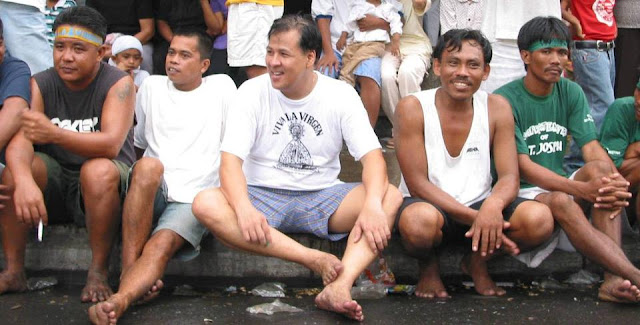What Do Those Slippers Really Mean?
Actually, in the photograph below, Jesse Robredo is sitting on a sidewalk with other men barefoot. In wearing slippers or going barefoot, there is an obvious sense of humility. What should not be missed in this picture is that Robredo is sitting with other men. It is a humbleness that is rooted in recognizing that the challenges and victories in life are shared. Robredo's slippers need to be understood in the proper context of his ideal of allowing and encouraging citizen participation in
government decision making. This ideal is best appreciated in Robredo's approach to solving problems in basic education.
Robredo served as mayor of Naga City for three consecutive terms starting in 1989 and another three consecutive terms from 2001. Naga City was home to schools that were apparently ranked first in the Bicol region based on results of National Achievement Tests. Robredo, however, noticed that the ranking was actually hiding something very dismal. Naga City's mean performance score was way below 50 percent. Students from the city were giving the wrong answers more than half the time. Robredo realized how important it was to acknowledge that there was a serious problem.
Michael Scharff of Princeton University wrote the following in a case study for Innovations for Successful Societies:
Note: A previous post in this blog, "Jesse M. Robredo on the Role of Local Government in Basic Education", presents Robredo's own vision for a local school board.
 |
| Photo copied from Team Robredo |
Robredo served as mayor of Naga City for three consecutive terms starting in 1989 and another three consecutive terms from 2001. Naga City was home to schools that were apparently ranked first in the Bicol region based on results of National Achievement Tests. Robredo, however, noticed that the ranking was actually hiding something very dismal. Naga City's mean performance score was way below 50 percent. Students from the city were giving the wrong answers more than half the time. Robredo realized how important it was to acknowledge that there was a serious problem.
Michael Scharff of Princeton University wrote the following in a case study for Innovations for Successful Societies:
...The Ford Foundation—a major international donor—approached Robredo in 2001 with the idea of stimulating citizen involvement in the decisions made by local school boards, which had the final say on most local education matters, including spending. Until that time, school boards had been small, insular groups led by superintendents who were appointed by the Department of Education in Manila. With the assistance of the Ford Foundation, Robredo broadened the membership of the school boards to include parents and teachers and educated the community about the most pressing needs in the schools. As a consequence, communities played a greater role in prioritizing the needs at each school and deciding where to target funds. This in turn led to, among other things, better quality textbooks and improved student performance, as measured by standardized test scores....To appreciate what this reform has accomplished, the following is an excerpt from a Request for Application (RFA) from USAID:
In one of the most successful cases of the transformative impact of education decentralization, Naga City showed a massive increase in the performance of its students in the National Achievement Test. From 38.1 mean percentage score in 2000 (a year before governance reforms were introduced by its mayor), the scores jumped by more than 12 points to 50.58 in 2004, and a further ten points to 60.10 in 2005.Synergeia describes Jesse Robredo's education reform with the following paragraph:
In the case of Naga City, the community supplied the inputs that can influence learning which the DepEd could not provide. Barangay officials took charge of security of children and schools. They served as lookouts for children who were dropping out. Members of the Kabataang Baranggay contributed to the provision of textbooks. And long before the “Pantawid Pamilya" became a national program, Mayor Robredo already instituted an incentive system for indigent parents to send their children to school. For every day that the child was in school, the child got one ganta of rice or two cavans of rice for a perfect attendance during the school year. His mother also got a premium for attending PTA meetings. She took home another ganta of rice. “I will not prescribe any template”, Mayor Robredo said. “You are in the best position to design your own templates because you understand your own terrain and can introduce the needed innovations.” He cited another example where children in a school that was located at the foot of Mt. Isarog did not go back to school after lunch because of the distance between their homes and the school. The city started a feeding program to keep the children in school.Good governance goes much farther than wearing slippers. In basic education, like any other government's responsibility, acknowledging the problems is the first step. The next step is empowerment. In education, it is the empowerment of teachers and parents.
Note: A previous post in this blog, "Jesse M. Robredo on the Role of Local Government in Basic Education", presents Robredo's own vision for a local school board.
Comments
Post a Comment